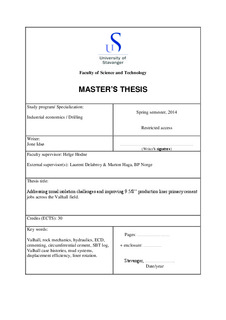| dc.contributor.author | Idsø, Jone | |
| dc.date.accessioned | 2014-12-17T12:26:19Z | |
| dc.date.available | 2014-12-17T12:26:19Z | |
| dc.date.issued | 2014-06-12 | |
| dc.identifier.uri | http://hdl.handle.net/11250/227623 | |
| dc.description | Master's thesis in Industrial economics | nb_NO |
| dc.description.abstract | Placing cement in the annulus between a casing string and the borehole is essential to obtain compliant zonal isolation. Circumferentially bonded cement provide a hydraulic seal which prevents cross flow between permeable zones, flow to surface and sustained casing pressure during the lifetime of a wellbore. The 9 5/8" production liner primary cement jobs across the depleted Valhall field are challenging. A very tight operating window between the collapse pressure and the fracture gradient is a limitation when designing the cement jobs. A trade-off between dynamic wellbore pressures and industry acknowledged cement guidelines such as high displacement rates, density hierarchy and rheology hierarchy is needed to stay within the pressure limits. Six case histories from the Valhall field are presented and evaluated to determine the most critical elements of a successful primary cement job. All wells have been acoustically logged to evaluate the annular cement bond quality.
Lost circulation events in the deeper parts of the hole section have proven to be the greatest challenge when cementing the 9 5/8" production liner. No common loss zone has been identified, but getting cement above the limestone stringer area in the Intra Late Eocene has proven difficult. ECD (equivalent circulating density) reducing measures such as low density pre-flushes, riser drainage, underreaming and low-rheology mud systems are discussed and quantified by the use of fundamental fluid mechanics. Underreaming the 12 1/4" section to 13" in combination with a carefully designed mud program have been identified as the main contributors to decrease the ECD.
Gelled-up mud, eccentric casing strings and low annular velocities during the cement displacement process increase the risk of cement channeling. Liner rotation has been documented as the most influential parameter in terms of obtaining suffcient intervals of circumferentially bonded cement. Simulations have shown that the ECD effect from liner rotation at low rotational speeds is negligible. An evaluation of three different mud systems and their respective effect upon displacement effciency is presented.
A subjective evaluation of the main factors affecting the outcome of the 9 5/8" primary cement jobs has been performed. Based upon the evaluation a recommendation aiming to maximize the probability of successful future 9 5/8" liner primary cement jobs across Valhall is presented. | nb_NO |
| dc.language.iso | eng | nb_NO |
| dc.publisher | University of Stavanger, Norway | nb_NO |
| dc.relation.ispartofseries | Masteroppgave/UIS-TN-IØRP/2014; | |
| dc.rights | Attribution-NonCommercial-NoDerivs 3.0 Norway | * |
| dc.rights.uri | http://creativecommons.org/licenses/by-nc-nd/3.0/no/ | * |
| dc.subject | ECD | nb_NO |
| dc.subject | industriell økonomi | nb_NO |
| dc.subject | wellbore cementing | nb_NO |
| dc.subject | lost circulation | nb_NO |
| dc.subject | Valhall | nb_NO |
| dc.title | Addressing zonal isolation challenges and improving 9 5/8" production liner primary cement jobs across the Valhall field | nb_NO |
| dc.type | Master thesis | nb_NO |
| dc.subject.nsi | VDP::Technology: 500::Rock and petroleum disciplines: 510 | nb_NO |
| dc.subject.nsi | VDP::Social science: 200::Economics: 210 | nb_NO |

